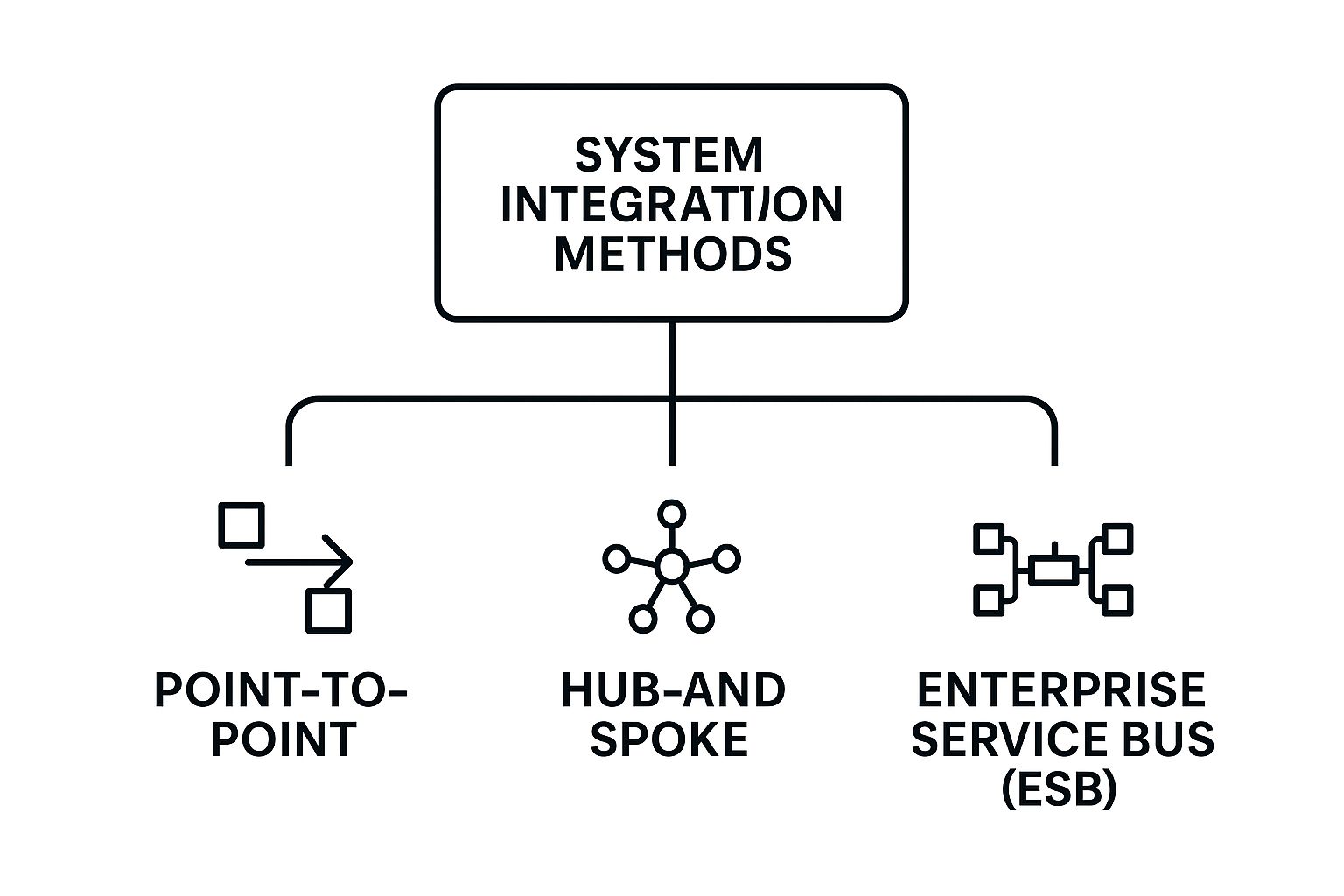What is System Integration? Boost Your Business Efficiency
- Matthew Amann
- 1 day ago
- 13 min read
System integration is all about getting your different business software to talk to each other. Think about all the separate tools you use—your CRM, accounting package, inventory management, and so on. Integration is the digital glue that binds them together, letting them share data and automate tasks as if they were a single, cohesive unit. This process tears down the walls between departments and creates one unified operational backbone.
Breaking Down Digital Barriers
Imagine your business is a team of all-stars. The sales team has its CRM, finance has its accounting software, and the warehouse runs on an inventory platform. Each tool is fantastic at its job, but they don't speak the same language. This communication gap turns your employees into human bridges, manually transferring data from one system to another. It's slow, boring, and a recipe for mistakes. This is precisely why getting a handle on what is system integration is so important.
System integration acts as the universal translator and central nervous system for your entire operation. It builds the digital pathways between these isolated software islands, creating a smooth, uninterrupted flow of information. For example, when a salesperson marks a deal as "won" in the CRM, a good integration can automatically generate an invoice in the accounting system and adjust stock levels in the warehouse. No one has to lift a finger.

Core Goals of System Integration
This isn't just a tech project for the sake of connecting apps; it’s a strategic move to make your whole business run smarter. The main goals are pretty straightforward:
Automate Workflows: Get rid of the mind-numbing, repetitive data entry by setting up automated processes that work across different applications.
Create a Single Source of Truth: Pull all your data together so that everyone, from sales to support, is working from the same accurate, real-time information.
Improve Operational Efficiency: When processes are faster and errors disappear, your team can finally stop wasting time on data chores and focus on what actually grows the business.
To put it all together, here is a quick overview of what system integration aims to achieve.
System Integration at a Glance
Component | Description | Primary Goal |
|---|---|---|
Data Synchronization | Keeping information consistent across all connected systems. | Establish a single, reliable source of truth. |
Workflow Automation | Triggering actions in one system based on events in another. | Eliminate manual tasks and reduce human error. |
Unified Interface | Providing a centralized view of data from multiple sources. | Improve visibility and simplify decision-making. |
API Management | Securely connecting applications using their defined protocols. | Enable seamless and secure communication between software. |
Ultimately, a well-integrated system lets you see the complete picture, making it easier to serve customers, spot trends, and scale your operations smoothly.
By linking disparate systems, organizations can achieve a level of operational harmony that is impossible when departments work in isolation. It transforms a collection of individual tools into a powerful, cohesive machine that drives business growth.
In the end, system integration is about making your technology work for you, not against you. It dismantles the digital barriers that cause friction and inefficiency, giving you a solid foundation for smarter decisions, better customer service, and sustainable growth.
Why System Integration Is Essential for Business Growth
It's one thing to know what system integration is, but the real lightbulb moment comes when you understand why it's become a cornerstone of modern business strategy. Without it, companies are essentially operating with digital blinders on. Each department gets a tiny sliver of the big picture, but no one sees the whole thing. This disconnect, what we call a "data silo," is a massive source of friction, inefficiency, and squandered opportunities.
System integration is the sledgehammer that tears down those internal walls. Think about it: a customer service rep is trying to solve a client's problem but can't see their purchase history from the sales system or their latest payment status from the accounting software. It's a clunky, frustrating experience for both the employee and the customer. Integration stitches these separate systems together, creating a single source of truth where everyone is working from the same real-time, accurate information.

Driving Operational Excellence and Agility
One of the first things you'll notice is a huge boost in operational efficiency. When your Customer Relationship Management (CRM) and Enterprise Resource Planning (ERP) platforms finally talk to each other, workflows that used to take hours of mind-numbing manual work happen in a flash. Not only does this automation save a ton of time, but it also drastically cuts down on costly human errors.
This newfound efficiency gets your team out of the weeds of data entry and lets them focus on things that actually move the needle—like innovation, strategy, and building better customer relationships. There are some serious cost and productivity gains to be had here. For a deeper look, check out these 10 Ways a CRM or ERP System Can Reduce Costs and Boost Productivity. You can also explore more specific advantages in our guide on the top benefits of automating business processes in 2025.
By creating a cohesive IT ecosystem, businesses can respond to market changes faster, make more informed decisions, and deliver a superior, unified customer experience. Integration isn't just about connecting software; it's about building a more resilient and agile organization.
Meeting Modern Market Demands
The push for digital transformation isn't slowing down. Companies everywhere are ditching their fragmented legacy systems for integrated solutions that bring hardware, software, and data together into a well-oiled machine. This is especially true for real-time data integration, which gives businesses the agility to make smart decisions on the fly. Connecting an ERP system is often a major catalyst, as it pulls various business functions into one operational hub.
At the end of the day, system integration delivers real-world results that are non-negotiable in today's market. The key benefits really boil down to this:
Improved Decision-Making: When leaders have access to comprehensive data from across the company, they can make strategic calls based on the full story, not just a single chapter.
Enhanced Customer Experience: A 360-degree view of the customer journey means you can provide personalized, consistent, and proactive service at every single touchpoint.
Greater Scalability: As your business grows, a properly integrated foundation lets you plug in new tools and processes without just creating more chaos and new data silos.
By connecting your tech stack, you're not just linking apps—you're building a powerful, unified engine that's ready to achieve operational excellence and stay ahead of the competition.
Common Approaches to System Integration
So, we know why system integration is a game-changer, but how does it actually happen? Getting different software to talk to each other isn't a one-size-fits-all job. There are several tried-and-true methods, each with its own strengths, a bit like choosing the right tool for a specific task.
The Old-School Methods: Point-to-Point and Hub-and-Spoke
The most direct way to connect two systems is through point-to-point integration. Imagine running a dedicated phone line straight from your CRM to your accounting software. It's simple, direct, and works perfectly when you only have a couple of systems to link up.
The problem? As your business grows, so does the mess. Connecting five different apps this way requires 10 separate connections. Before you know it, you're looking at a tangled web that's a nightmare to maintain. This is often called "spaghetti integration," and for good reason.
To clean up that mess, the hub-and-spoke model came along. Picture a central airport (the hub) with flights coming in from various cities (the spokes). Instead of every system connecting directly to every other system, they all connect to one central hub.
This setup makes life much easier. The hub handles all the data translation and routing. If you need to swap out one of your "spoke" systems, you only have to change one connection—the one to the hub—not a dozen individual links.

Taking this a step further, you have the Enterprise Service Bus (ESB). Think of an ESB as a super-smart logistics network for your company's data. It doesn’t just pass information along; it can also transform data formats, manage complex workflows, and enforce security policies. It's a powerful backbone for large organizations.
Today’s Go-To: Cloud and API-Based Integration
With the explosion of cloud-based software, integration methods have become much more nimble and accessible.
API-Led Connectivity: This is the modern standard. An Application Programming Interface (API) is like a universal adapter for software. It exposes specific functions and data in a secure, standardized way, allowing other applications to easily plug in and communicate. It’s like using LEGO bricks—each piece is designed to connect with others seamlessly.
iPaaS (Integration Platform as a Service): These are cloud platforms built specifically for integration. Think of tools like Zapier or Make. They offer a "mission control" dashboard with pre-built connectors that let you visually build, manage, and monitor data flows between your apps, often without writing a single line of code.
These newer approaches have really leveled the playing field, making powerful integration possible for businesses of any size. The best method for you will depend on your budget, the complexity of your needs, and how much you expect to grow.
Comparing System Integration Approaches
Choosing the right integration method is critical. This table breaks down the main options to help you see which one might be the best fit for your situation.
Integration Method | Key Advantage | Primary Disadvantage | Best For |
|---|---|---|---|
Point-to-Point | Simple and fast for connecting just two systems. | Becomes incredibly complex and hard to manage as more systems are added. | Basic, one-off integrations between a pair of applications. |
Hub-and-Spoke | Centralized management simplifies adding or changing systems. | The central hub can become a bottleneck if not properly managed. | Mid-sized businesses needing a structured way to connect multiple core systems. |
ESB | Robust, powerful, and handles complex data transformations. | Expensive and complex to implement and maintain. | Large enterprises with extensive, mission-critical integration needs. |
API-Led & iPaaS | Flexible, scalable, and often user-friendly with pre-built connectors. | Can lead to subscription costs and reliance on a third-party platform. | Businesses of all sizes using cloud-based apps and needing agility. |
Ultimately, the goal is to create a connected ecosystem that supports your business, not one that holds it back with complexity.
If you're exploring the world of iPaaS and other automation tools, knowing what to look for is half the battle. Our guide on choosing the right workflow automation platforms offers a deeper dive to help you make a smart decision.
System Integration Examples in the Real World
Theory is great, but seeing system integration in action is where it really clicks. Across every industry, connecting separate systems is what drives efficiency, creates better customer experiences, and builds smarter operations. Let's look at a few examples of how this solves real, everyday business problems.

From doctor's offices to online stores, the need for a truly connected digital ecosystem is exploding. This isn't just a trend; it's a massive market shift. Projections show the global system integration market rocketing from USD 461.36 billion in 2024 to an estimated USD 1,116.68 billion by 2033. The engine behind that growth? A widespread push for more automation and cloud-based services. You can explore the full projections to see just how fast this space is moving.
Transforming Patient Care in Healthcare
In healthcare, scattered information isn't just an inconvenience—it can be dangerous. System integration is the solution, creating a single, comprehensive view of a patient's journey.
Think about a typical doctor's visit. When a physician updates a patient's Electronic Health Record (EHR), a series of connections can kick into gear instantly.
Billing and Insurance: The billing department gets an automatic update, which means less manual entry and fewer errors on insurance claims.
Pharmacy: The prescription zips over to the pharmacy, where it can be cross-referenced with the patient's record to flag potential drug interactions.
Labs and Specialists: New lab results are automatically filed into the EHR, and any referral to a specialist can include the patient's complete medical history, right from the start.
This creates a smooth, continuous path for patient care. It cuts down on administrative headaches and, most importantly, frees up clinicians to focus on what they do best: helping people.
Creating Seamless Retail Experiences
Modern retail is all about delivering a perfect customer experience, and that’s simply impossible without solid integration. When you buy something online, you're kicking off an automated chain reaction behind the scenes.
A well-integrated retail operation ensures that the customer's online click translates into a perfectly executed real-world delivery, building trust and loyalty through flawless execution.
The e-commerce platform acts as the nerve center, talking to several other critical systems:
Inventory Management: The second an order is placed, stock levels are adjusted in real-time across every sales channel—the website, the mobile app, and physical stores. This is what prevents overselling popular items.
Supply Chain and Logistics: The warehouse gets the order details instantly, which triggers the picking, packing, and shipping process without anyone needing to lift a finger.
Customer Relationship Management (CRM): The purchase is logged in the customer's profile, paving the way for personalized marketing emails and relevant follow-ups.
Securing Transactions in Finance
The financial world runs on speed, accuracy, and security. System integration is the invisible framework that makes modern banking work. When you swipe or tap your credit card, multiple systems communicate in milliseconds to approve that transaction.
The bank’s core platform is constantly talking to sophisticated fraud detection systems. These systems analyze the purchase against your typical spending habits and location in real-time. If something looks off—a large purchase in a city you've never visited, for instance—the transaction is flagged or blocked immediately. This protects both you and the bank without slowing down the flow of commerce.
How to Navigate Common Integration Challenges
As great as system integration sounds, the reality is that these projects are rarely a walk in the park. They often mean untangling a messy web of technical, financial, and even people-related problems. Knowing what you're up against from the start is the first step to creating a plan that actually works.
One of the biggest headaches? Legacy systems. So many businesses run on old, on-premise software that’s absolutely essential but was built long before anyone thought about connecting it to a cloud app. These relics often lack modern APIs or use data formats from a bygone era, making it a tough and costly puzzle to solve.
It's a bit like trying to plug a vintage record player into a new Bluetooth speaker. You can’t just connect them directly; you need a special adapter—a bridge between the old and the new. In the tech world, this often means building custom solutions or using specialized middleware to get them talking.
Addressing Security and Data Integrity
When you start connecting systems that were once isolated, you're essentially opening new doors for data to travel through. If you're not careful, those doors can become security risks. Every connection point is another potential vulnerability that needs to be locked down.
A solid security plan is non-negotiable and should include:
Data Encryption: Protecting your data whether it's moving between systems or just sitting there.
Access Control: Setting up strict rules about who (and what) gets to see or touch sensitive information.
Regular Audits: Keeping a constant eye on the entire setup to spot threats or compliance gaps before they become problems.
Beyond just security, you have to make sure the data itself stays accurate and complete during the move. Shifting massive amounts of information from one place to another is a delicate operation. For a deeper dive, it's worth checking out some proven strategies for handling this. Our guide on 8 best practices for data migration to implement in 2025 covers this in detail.
It's a sobering thought, but some studies show that up to 70% of integration projects either struggle significantly or don't hit all their goals. This really drives home how critical careful planning and skilled execution are to sidestepping the common traps.
Finally, don't underestimate the cost and people-power involved. A successful integration requires a serious budget and a significant time commitment from your best tech talent and project managers. Without a clear scope and strong leadership, it's incredibly easy for costs to spiral and deadlines to fly by, wiping out the very benefits you were trying to achieve in the first place.
The Future of System Integration
System integration isn't just a technical job anymore; it's moving from the server room to the boardroom. The connections we're building today are becoming the strategic core of how businesses operate, innovate, and even survive. This isn't just about making things work together—it's about making them work smarter.
At the heart of this shift are technologies like Artificial Intelligence (AI) and Machine Learning. Forget the old, rigid integrations that followed a strict set of rules. The future is about creating systems that can think for themselves. Imagine an integration that detects a bottleneck in your data flow, reroutes it, and fixes the issue before a human even knows there’s a problem. That’s where we're headed.
The Impact of Pervasive Connectivity
Then you have the Internet of Things (IoT), which is throwing gasoline on the fire. We're not just connecting apps anymore. We're connecting billions of devices—factory sensors, smart thermostats, delivery drones, you name it. All of these devices are creating a tsunami of data that needs to be integrated in real-time.
This flood of data and connectivity is the engine behind hyperautomation, a concept where businesses try to automate literally everything they can. System integration is the central nervous system that makes this possible, linking everything from your CRM to AI agents and robotic process automation (RPA) bots.
In the coming years, integration will no longer be about simply connecting A to B. It will be about creating an intelligent, adaptable digital ecosystem that can respond to business needs in real time.
The market is responding to this seismic shift. The system integration market in the United States was already valued at a massive USD 130.23 billion in 2024. But get this—it's projected to skyrocket to USD 500.85 billion by 2034.
What’s driving that incredible growth? The relentless move to cloud services, the explosion of industrial IoT, and the rollout of 5G networks. You can discover more about these market projections and see the data for yourself. The takeaway is clear: system integration has graduated from an IT task to a fundamental pillar of modern business.
Frequently Asked Questions
Still have some questions about how system integration works and what it means for you? We get it. Let's tackle some of the most common ones we hear from business leaders.
What's the Difference Between System and Application Integration?
Think of it like building a house. System integration is the big-picture job of connecting all the major utilities—the plumbing, the electrical grid, and the HVAC system. It’s about making sure the entire infrastructure works together as a single, cohesive unit.
Application integration, on the other hand, is a more focused task. It’s like making sure your smart-home devices—your thermostat, speakers, and lights—can all talk to each other. It’s a subset of the larger project, specifically about making software applications communicate seamlessly.
How Do I Know if My Business Needs System Integration?
You probably feel the need for integration every day, even if you don't call it that. Is your team spending hours manually copying and pasting information from one app to another? Are you making costly mistakes because the data in your sales system doesn't match the data in your inventory system?
These aren't just minor annoyances; they're symptoms of disconnected systems.
The biggest red flag is when you can't get a single, clear view of your business performance because all your crucial data is locked away in different software silos. If that sounds familiar, integration is the answer.
Can Small Businesses Actually Afford This?
Yes, absolutely. It’s a common misconception that system integration is only for huge corporations with massive IT budgets. That might have been true a decade ago, but the game has completely changed. Modern tools, especially cloud-based platforms known as Integration Platform as a Service (iPaaS), have made powerful integration accessible and affordable for everyone.
Small businesses can get started with small, high-impact projects that deliver a quick return on investment. For instance:
Connect your e-commerce store directly to your accounting software to automate invoicing.
Link your CRM to your email marketing platform for perfectly synced customer campaigns.
Sync your project management tool with your time-tracking app to make payroll a breeze.
These kinds of targeted automations save small teams an incredible amount of time and cut down on manual errors, all without a hefty upfront cost.
Ready to stop wasting time on manual tasks and build a truly connected business? Flow Genius specializes in designing and implementing smart automation solutions that eliminate efficiency gaps and drive growth. Book a discovery call today to build your automation blueprint!